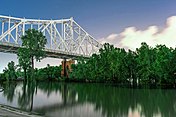
Back Baton Rouge Afrikaans ባተን ሩዥ Amharic Baton Rouge AN Rēadstic ANG باتون روج (لويزيانا) Arabic باتون روچ (لويزيانا) ARZ Baton Rouge AST Baton-Ruj (Luiziana) Azerbaijani باتونروژ، لوئیزیانا AZB Baton Ružos BAT-SMG
Baton Rouge
Bâton-Rouge (French) Batonrouj (Louisiana Creole) | |
|---|---|
|
| |
| Etymology: from French bâton rouge 'red stick' | |
| Nicknames: Red Stick, The Capital City, B.R. | |
Interactive map of Baton Rouge | |
| Coordinates: 30°26′51″N 91°10′43″W / 30.44750°N 91.17861°W | |
| Country | United States |
| State | Louisiana |
| Parish | East Baton Rouge |
| Founded | 1699 |
| Settled | 1721 |
| Incorporated | January 16, 1817 |
| Government | |
| • Mayor-President | Sharon Weston Broome[1] (D) |
| Area | |
| • State capital city and consolidated city-parish | 88.52 sq mi (229.27 km2) |
| • Land | 86.32 sq mi (223.56 km2) |
| • Water | 2.20 sq mi (5.71 km2) |
| • Total[note 1] | 79.11 sq mi (204.89 km2) |
| Elevation | 46 ft (14 m) |
| Population (2020) | |
| • State capital city and consolidated city-parish | 227,470 |
| • Rank | US: 107th |
| • Density | 2,635.32/sq mi (1,017.50/km2) |
| • Urban | 631,326 (US: 67th) |
| • Urban density | 1,592.9/sq mi (615.0/km2) |
| • Metro | 870,569 (US: 66th) |
| Demonym | Baton Rougean |
| Time zone | UTC−6 (CST) |
| • Summer (DST) | UTC−5 (CDT) |
| ZIP Codes | 70801–70817, 70819–70823, 70825–70827, 70831, 70833, 70835–70837, 70874, 70879, 70883, 70884, 70892–70896, 70898 |
| Area code | 225 |
| FIPS code | 22-05000 |
| GNIS feature ID | 1629914 |
| Website | www |
Baton Rouge (/ˌbætən ˈruːʒ/ BAT-ən ROOZH; French: Baton Rouge or Bâton-Rouge, pronounced [bɑtɔ̃ ʁuʒ]; Louisiana Creole: Batonrouj) is the capital city of the U.S. state of Louisiana. Located on the eastern bank of the Mississippi River, it had a population of 227,470 as of 2020[update];[4] it is the seat of Louisiana's most populous parish (county-equivalent),[5][6] East Baton Rouge Parish,[7] and the center of Louisiana's second-largest metropolitan area and city, Greater Baton Rouge.[5]
The Baton Rouge area owes its historical importance to its strategic site upon the Istrouma Bluff, the first natural bluff upriver from the Mississippi River Delta at the Gulf of Mexico. This allowed development of a business quarter safe from seasonal flooding. In addition, it built a levee system stretching from the bluff southward to protect the riverfront and low-lying agricultural areas.[8]
Baton Rouge has developed as a culturally rich center, with settlement by immigrants from numerous European nations and African peoples brought to North America as slaves or indentured servants. It was ruled by seven different nations: the French, Spanish and British in the colonial era; briefly the Republic of West Florida; the United States as a territory and a state; the Confederate States of America; and the United States again since the end of the American Civil War. Throughout the governance of these various occupying national governments of Baton Rouge, the city and its metropolitan area have developed as a multicultural region practicing many religious traditions from Catholicism to Protestantism and Louisiana Voodoo.
Baton Rouge is a major, growing industrial, petrochemical, medical, research, motion picture,[9] and technology center of the American South.[10] It is the location of Louisiana State University—the LSU system's flagship university and the state's largest institution of higher education.[11] It is also the location of Southern University, the flagship institution of the Southern University System—the nation's only historically black college system.[12]
The Port of Greater Baton Rouge is the tenth-largest in the U.S. by tonnage shipped, and it is the farthest upstream Mississippi River port capable of handling Panamax ships.[13][14] Major corporations participating in the Baton Rouge metropolitan statistical area's economy include Amazon, Lamar Advertising Company, BBQGuys, Marucci Sports, Piccadilly Restaurants, Raising Cane's Chicken Fingers, ExxonMobil, Brown & Root, Shell, and Dow Chemical Company.
- ^ "Office of Mayor President". Baton Rouge Government Website. Archived from the original on January 7, 2017. Retrieved January 3, 2017.
- ^ "2020 U.S. Gazetteer Files". United States Census Bureau. Retrieved March 20, 2022.
- ^ "Geographic Names Information System". edits.nationalmap.gov. Retrieved May 5, 2023.
- ^ "2019 Demographic and Housing Census for East Baton Rouge Parish, Louisiana". United States Census Bureau.
- ^ a b "2020 Population and Housing State Data". United States Census Bureau. Retrieved August 18, 2021.
- ^ "Local Louisiana". Government of Louisiana. Retrieved December 12, 2022.
The state of Louisiana is divided into 64 parishes, which are analogous to counties in other states. There are various forms of government being used within the parishes.
- ^ "East Baton Rouge Parish". Government of Louisiana. Retrieved December 12, 2022.
- ^ "LSU Libraries - Special Collections - Andrew David Lytle, photographic artist - Baton Rouge: Levee Construction, Mississippi River". Louisiana State University. Archived from the original on August 29, 2008. Retrieved July 29, 2021.
- ^ "Growing Louisiana-Based Businesses Sustains Hollywood South" Archived February 27, 2018, at the Wayback Machine, Forbes, June 9, 2014
- ^ "IBM selects BR" Archived May 26, 2016, at the Wayback Machine, The Advocate – Baton Rouge, LA
- ^ "About". Louisiana State University. Archived from the original on February 20, 2018. Retrieved February 26, 2018.
- ^ "Louisiana historically black universities host inaugural 'HBCU Day at the Capitol'". Southern University and A&M College. April 26, 2019. Retrieved December 12, 2022.
- ^ "Top 25 Water Ports by Weight: 2004 (Million short tons)". Freight Facts and Figures 2006. Federal Highway Administration. November 2006. Archived from the original on November 21, 2007. Retrieved August 18, 2007.
- ^ "About the Port". portgbr.com. Archived from the original on February 6, 2011. Retrieved April 27, 2011.
Cite error: There are <ref group=note> tags on this page, but the references will not show without a {{reflist|group=note}} template (see the help page).













